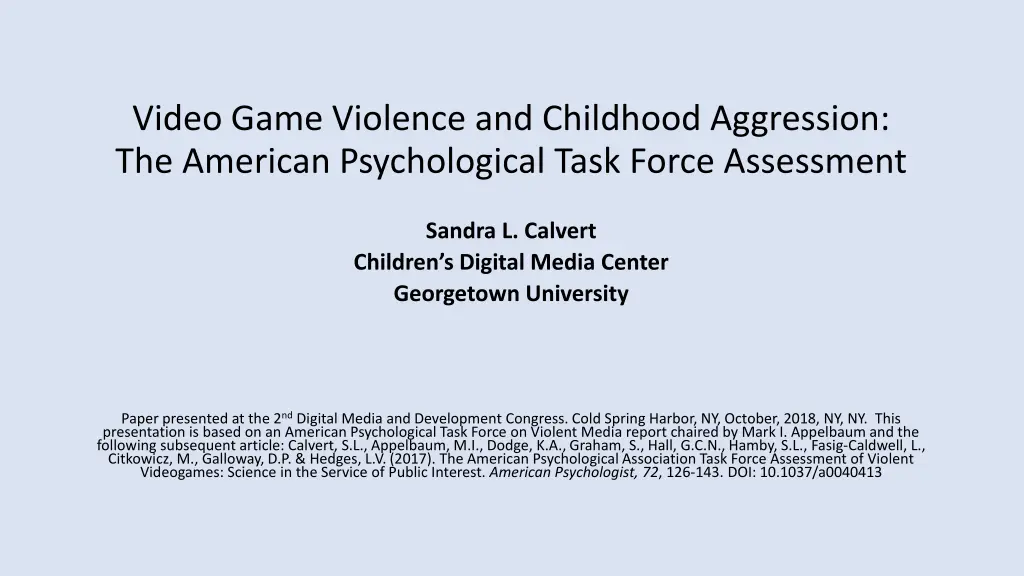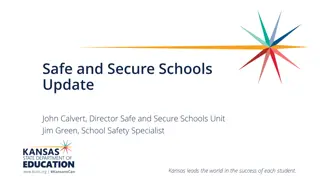
American Psychological Task Force Assessment on Video Game Violence and Childhood Aggression
Explore the findings of the American Psychological Task Force on the impact of violent video game use on childhood aggression. The task force reviewed literature from 2009-2013, including meta-analyses, to evaluate the relationship between violent video games and negative outcomes. Discover the two-pronged approach used for the literature review and insights from prior meta-analytic reviews.
Download Presentation

Please find below an Image/Link to download the presentation.
The content on the website is provided AS IS for your information and personal use only. It may not be sold, licensed, or shared on other websites without obtaining consent from the author. If you encounter any issues during the download, it is possible that the publisher has removed the file from their server.
You are allowed to download the files provided on this website for personal or commercial use, subject to the condition that they are used lawfully. All files are the property of their respective owners.
The content on the website is provided AS IS for your information and personal use only. It may not be sold, licensed, or shared on other websites without obtaining consent from the author.
E N D
Presentation Transcript
Video Game Violence and Childhood Aggression: The American Psychological Task Force Assessment Sandra L. Calvert Children s Digital Media Center Georgetown University Paper presented at the 2ndDigital Media and Development Congress. Cold Spring Harbor, NY, October, 2018, NY, NY. This presentation is based on an American Psychological Task Force on Violent Media report chaired by Mark I. Appelbaum and the following subsequent article: Calvert, S.L., Appelbaum, M.I., Dodge, K.A., Graham, S., Hall, G.C.N., Hamby, S.L., Fasig-Caldwell, L., Citkowicz, M., Galloway, D.P. & Hedges, L.V. (2017). The American Psychological Association Task Force Assessment of Violent Videogames: Science in the Service of Public Interest. American Psychologist, 72, 126-143. DOI: 10.1037/a0040413
Background Background A task force of experts was convened by the American Psychological Association (APA) to update the knowledge and policy about the impact of violent video game use on potential adverse outcomes. This APA Task Force on Media Violence examined the existing literature, including the meta-analyses in the field, since the last APA report on media violence in 2005. Because the most recent meta-analyses were published in 2010 and reflected work through 2009, the task force conducted a search of the published studies from 2009-2013.
Literature Review Literature Review To undertake the literature review, the task force adopted a two-pronged approach to identify the literature to be included. First, we conducted a comprehensive search of PsycINFO, MEDLINE, ScienceDirect, Social Science Research Network, ERIC, Google Scholar, ProQuest, Wilson Social Science Index and miscellaneous journals and references discovered through the search process. Used the following key words: violent video games, violence, violen*, aggressive behavior, aggression, aggress*, prosocial*, prosocial behavior, computer games, video*, game*, video games and media. Literature to be considered restricted to research focused on violent video game use separately from other forms of violent media.
Literature Review Literature Review Second, based on an initial PsycINFO search, we contacted approximately 130 of the most frequently published researchers in the topic area to request nominations of the 10 strongest empirically based articles addressing violent video game use published between 2000 and 2013. This process yielded four meta-analyses conducted since the last 2005 APA resolution that were directly relevant to the task force s charge to evaluate the literature related to violence in video games.
Prior Recent Meta Prior Recent Meta- -analyses of Violent Video Games Violent Video Games analyses of The four meta-analytic reviews that the task force identified examined the impact of violent video game use on a variety of negative outcomes All found reasonably similar statistically significant effects, albeit interpreted quite differently (Anderson et al., 2010; Ferguson 2007a; Ferguson 2007b; Ferguson & Kilburn 2009). These meta-analyses reviewed more than 150 research reports, including more than 400 effect sizes. A composite aggression score, aggressive behavior, aggressive cognition, aggressive affect, physiological arousal, reduced prosocial behavior, reduced empathy/desensitization, and criminal violence were included in at least one meta-analysis. These variables became our focus, as we assessed the new literature after 2009 through August of 2013.
Two Approaches: Systematic Evidentiary Two Approaches: Systematic Evidentiary Review and Meta Review and Meta- -Analysis Analysis Systematic Evidentiary Review (Zief & Agodini, 2012) Includes a clear set of objectives with pre-defined eligibility criteria used to include studies in the review Explicit methodology A systematic search that attempts to identify all studies that meet the criteria An assessment of the findings in the studies identified A systematic presentation of characteristics & findings in the included studies Conclusions based on the evidentiary review
Relevant Literature Relevant Literature Repeated the literature search process to capture all relevant articles that became publicly available between January 1, 2009 (since the last meta analyses by Anderson et al., 2010) and August 12, 2013. 170 new research reports
170 Reports Screened using Inclusion Criteria 170 Reports Screened using Inclusion Criteria Developed by the Task Force Developed by the Task Force 1) Does the report include at least one empirical analysis addressing video game violence separately from other media violence? 2) Does the analysis include complete statistics? 3) Does the report include at least one outcome variable considered in the earlier meta-analyses: a composite score of aggression, aggressive behavior, aggressive cognitions, aggressive affect, physiological measures, reduced prosocial behavior, reduced empathy/desensitization, delinquency or violence? 4) Does the report include some measurement of violent video game exposure? 5) Does the report include some description or assessment to determine that the violent video game is, in fact, violent? 6) Is the study published in a peer-reviewed academic journal?
Sample Selection Sample Selection 68 of the 170 articles (n = 78 studies) met all six screening criteria Each study then rated on a 3 point scale (high, medium, low) for: Possibility for causal inference Ecological validity Sampling validity Measurement of independent & dependent variables Created high & low utility groups, Kappa = .789 Yield was 31 high utility studies
Key Findings from the Evidentiary Review of High Key Findings from the Evidentiary Review of High Utility Studies (n = 31) Utility Studies (n = 31) Exposure to violent video games associated with Increases in aggressive behavior, aggressive thoughts, aggressive feelings Decreases in prosocial behaviors, empathy & sensitivity to aggression Findings Robust: Crossed a variety of different kinds of methodologies, including experimental research Concluded: Exposure to violent video games is a risk factor for aggressive outcomes Insufficient studies that examine the link between Exposure to violent video games & delinquency, criminal behavior, or other violent outcomes An important area in need of additional research
Key Findings from the Evidentiary Review Key Findings from the Evidentiary Review Even when risk factors such as antisocial personality traits, delinquency, poor academic achievement, parental conflict, child and parent depression, and exposure to deviant peers were controlled: Relation between violent video game exposure & aggressive outcomes remained robust Data suggest that the magnitude of relation between exposure to violent video games and aggressive outcomes did not differ: For adolescents, college students & young adults. Very few studies on children under age 10.
Evidentiary Review: Evidentiary Review: Future Recommended Directions of Study Future Recommended Directions of Study Major gaps in the literature about the impact of violent video game exposure as a function of Gender, ethnicity & socio-economic status. Although more exposure to violent video games is associated with higher levels of aggressive outcomes Insufficient studies that examine dose-response relation links with violent video game exposure. Gaps in the literature Video game properties (e.g., plots, production features) Player perspective during video game use (e.g., 1stversus 3rdperson perspective, competition or cooperation) User motivations for using violent video games
Results of Meta-analysis for All Outcomes (n = 31 high utility studies) Ferguson & Kilburn (2009) Anderson et al (2010) Ferguson (2007a) Ferguson (2007b) New Studies Outcomes k, r, d, SE k ,r, d, SE k, r, d, SE k, r, d, SE Overall Composite 27, .080, .161. 18, .154, .312, .05* Aggressive Behavior 140, .192, .391, -* 5, .150, .303, -* 17, .040, .080, - * 7, .184, .374, .092* Aggressive Cognitions 95, .170, .345, -* 12, .250, .516, - 7, .360, .772, -* 8, .166, .336, .064* Aggressive Affect; 62, .100, .201, -^ 9, .093, .187, .074* Decreased Empathy/ 32, .179, .364, -+ Desensitization Physiological Arousal 29, .135, .272, - 4, .270, .561, - 3, .189, .384, .265 * denotes meta-analyses with corrections for publication bias, ^denotes aggressive affect analysis, +denotes decreased empathy/desensitization analysis. Note: k = studies, r = correlation metric, d= Cohen s d; SE = Standard Error
Policy Recommendations Policy Recommendations APA engage in public education and awareness activities by disseminating our findings to children, parents, teachers, judges, and other professionals who work with children in schools and communities. Called for tests of educational interventions directed at children, youth, and their families to determine whether violent video game use can be decreased or the adverse impact of their use can be decreased. Called for refinement of video game ratings by the Entertainment Software Ratings Board (ESRB).
Conclusions of the APA Task Force on Conclusions of the APA Task Force on Violent Video Games Violent Video Games The use of violent video games results in increases in overall aggression as well as increases in the individual variables of aggressive behaviors, aggressive cognitions, aggressive affect, desensitization, physiological arousal, and decreases in empathy. Did not find sufficient studies to evaluate whether there is a link between violent video game use and criminal behavior. Recommend additional research in a variety of areas, including more studies of younger children, ethnicity, gender, dose-response effects, and game characteristics. Conclude that the use of violent video game use is a risk factor for subsequent aggression.



